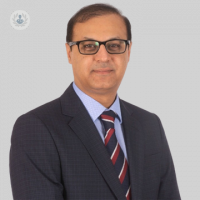Ankle fusion: A quick guide for patients
Escrito por:Ankle fusion, also known as arthrodesis, involves removing cartilage from joint surfaces and securing bones together with metalwork such as screws or plates, or both. The body then naturally heals the joint, resulting in the growth of new bone that solidifies the fusion process. In his latest online article, renowned consultant orthopaedic foot and ankle surgeon Mr Haroon Majeed answers patients’ most frequently asked questions about this procedure.

When is an ankle fusion recommended?
Ankle fusion becomes necessary when conventional pain management methods fail to alleviate arthritis-related discomfort, and ankle replacement isn't feasible. Despite sacrificing ankle mobility, fusion helps diminish pain and enhances overall joint functionality. Adjacent joints in the foot and leg often compensate for the lack of movement in the fused ankle.
What does the procedure entail?
Depending on ankle deformity severity, the procedure may be conducted via minimally invasive (keyhole) or open incision methods. Typically, screws or a plate are utilised to stabilise bones, supplemented by bone grafts sourced from local bone chips or synthetic materials to aid in proper healing.
Anaesthesia options, including general or spinal anaesthesia, are discussed preoperatively. Regional local anaesthesia targeting lower leg nerves is commonly administered for postoperative pain management.
What is the recovery process?
Post-surgery, ankle elevation and prescribed pain medications are recommended. Heparin injections may be administered for six weeks to prevent blood clot formation. You will wear wound dressings for the first two weeks following the surgery, until your first follow-up clinic visit. The ankle is transitioned into a walker boot with gradually increased weight bearing.
Clinic follow-ups at six weeks involve X-rays to assess healing progress, with mobilization continuing in the boot until complete healing, typically within 3-4 months. Full recovery may span 3-6 months or longer, depending on individual healing dynamics.
The incision is sealed using either removable sutures (to be taken out two weeks post-surgery) or absorbable sutures, which will be chosen by the surgeon. A temporary half-plaster of Paris slab will be placed behind your lower leg. Depending on your pain and mobility, a physiotherapist will decide how long you should stay in the hospital, typically 1 or 2 nights. For the next 6 weeks, you will utilize a walking frame or a pair of crutches, with weight bearing restricted to toe-touching on the operated leg.
Are there any potential complications?
There are several possible complications following the procedure. These complications include:
- infection
- wound issues
- bleeding
- blood clots (deep vein thrombosis, pulmonary embolism)
- delayed or incomplete healing
- ongoing pain
- nerve and vessel damage
- scar numbness
- chronic regional pain syndrome
- hardware-related problems necessitating further intervention
- long-term joint wear
- anaesthesia-related risks
While these complications are infrequent, certain medical conditions and long-term medication use can elevate associated risks.
Mr Haroon Majeed is an esteemed consultant orthopaedic foot & ankle surgeon based in Manchester and Wilmslow. If you would like to book a consultation with Mr Majeed, you can do so today via his Top Doctors profile.


